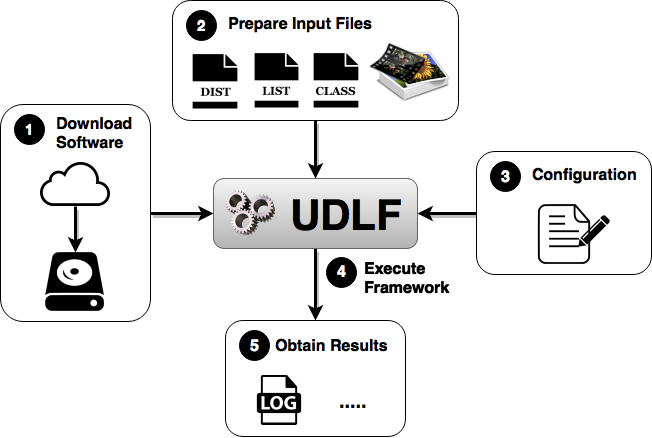

If you are new to this software and want to know the steps to use it, you are in the right place. This page will guide you in your first use. The figure below illustrates all the basic usage steps that are described as follows.

The software is multiplatform and can be downloaded in the releases page. There are binaries available. However, you may want to compile the source-code. The compilation process is very simple, there is a Makefile that does all the job. Just type "make" in your command line and you are done. To compile the source-code using Windows, we recommend the use of Cygwin.
Check the Releases »You need to choose the files that will be used as the input for the framework. Please check if your files are using the formats specified by the framework.
There are different files that you can use as input:
For your first use, we recommend to try the dataset files that we have provided in the required formats. They are ready to use.
The datasets considered are: Soccer, MPEG-7, and Brodatz.
The framework usage is mainly based on the configuration file, which specifies all information about the execution: the desired task, method being used, dataset information, input and output files, evaluation settings, and other details. In this way, no recompilation is necessary, such that the user is able to perform a totally different execution just by changing the configuration file.
Basically, values are attributed to parameters using the expression: PARAMETER = VALUE. Comments can be included using the character #, such that all the text after it is ignored. The parameters and values are case sensitive. You can write your configuration file following the example below or a complete example available here.

The executable is called in the terminal:
NOTE: The binary must be executed inside the bin/ directory.
When the binary is executed, it searchs for a config.ini file in its current directory. The user can also specify a different configuration file that can be passed as a parameter: ./udlf my_conf.ini. The software considers only a single configuration file per execution.
After the execution, the output files with the format and in the directories that were specified in the configuration file.
Besides that, a log.txt is also generated containing the information about the execution:

The results can be exported in different formats. Below you can see a example of ranked list that were exported as a html page. The query images are presented in green borders and wrong results in red borders. The first line represents the original retrieval results and the second line, the results after the algorithm execution.

NOTE: The above example consider the dataset MPEG-7.
We also recommend you to access the other tabs of this site and the software repository for further information.